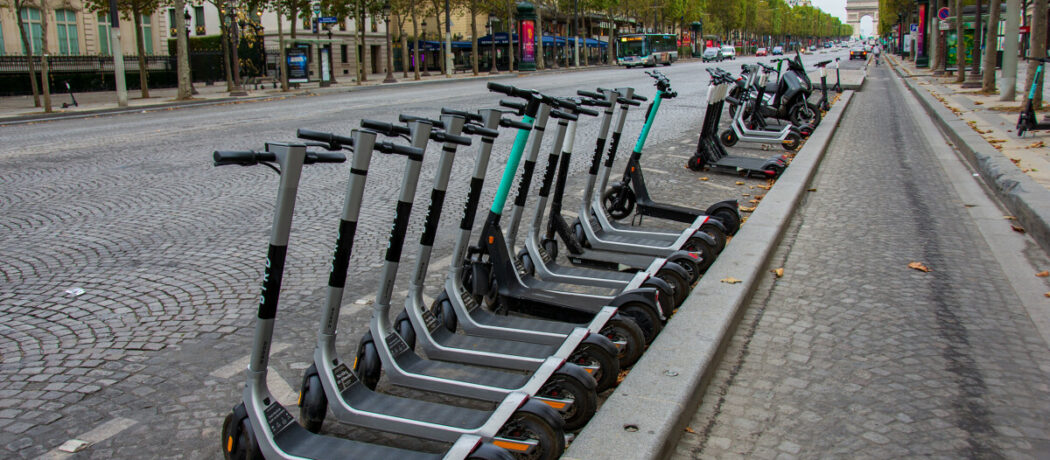E-scooters, bikes and urban mobility: lessons from the streets of Paris

Share
Mobility is a crucial challenge for global cities in the 21st century. The growing impact and immense risks of climate change are becoming clearer every day, and cities are on the front line. Globally, transportation generates 14% of all greenhouse gases, much of it for personal transportation.
To reduce their carbon footprint and increase mobility options, many cities have been investing in bike-share systems. One of the largest is Paris’s Velib’, with more than 14,000 bicycles. Launched in 2007, the system is built around docks – it’s there that customers pick up and drop off bikes, and they also serve as recharging stations for electric models.
Since 2017, a host of start-ups has emerged offering fleets of dockless bikes and electric scooters in cities around the world. The concept was simple: users downloaded an app and paid, grabbed a bike or scooter, and off they went, leaving it wherever they wanted after. Floating on an ocean of venture capital, the firms took advantage of a legal void and distributed thousands of bicycles and scooters in cities large and small around the world.
Destination, the City of Light
For mobility start-ups, Paris offered an irresistible target. The region’s population is more than 12 million and it attracted approximately 40 million tourists in 2017, each one a potential customer. For better or worse, the city’s leadership initially took a hands-off approach to free-floating bikes and scooters and the result was predictable: chaos.
At the height the boom in the summer of 2019, more than a dozen firms were filling Paris streets with vehicles of all sorts. Not only was the free-for-all bad for residents and visitors, it was cruel to the start-ups themselves. E-scooters in particular proved to cost far more than they bring in over their extremely short lives and the companies burned through their cash.
The result was high turnover, with firms exiting the market almost as quickly as they entered. At least six Paris e-scooter operators have “suspended operations” (read, given up), and that follows the departure of free-floating bikes from Gobee, Obike and Ofo. The most recent victim is Coup, an affiliate of Bosch, which announced November 25 that it would suspend operations in Paris and Berlin because its electric-scooter service was “economically non-viable”.
Despite the numerous failures and the city’s demand that companies show greater responsibility, the venture-capital-driven optimism continues. Newer entrants such as Jump, Wind and Donkey Republic are all hoping to beat the dockless jinx, and more will certainly come. This makes Paris an interesting case study, where regulatory loopholes and brute capitalism meet, with the city’s streets as the battlefield.
Easy come, easy go
A key puzzle is why the companies that were the first to arrive in Paris exited almost as quickly. Shouldn’t they have had “first-mover advantage”, allowing them to keep others at bay? Unfortunately, there were powerful economic realities at play in the micromobility space that made their reigns brief, and that will likely do away with many of the newer entrants as well.
- Low barriers to entry: When new firms enter an industry, there are often factors that protect existing operators – patents, deep pockets or regulations, for example. But all an e-mobility start-up needs are a modest amount of capital, a website and an app. Scooters are manufactured as cheaply as possible overseas, distributed in the targeted city, and from there it’s up to users and teams of freelance “juicers” to keep things moving. Operators can go wherever they deem attractive, and that’s bad news for existing operators.
- Non-existent switching costs: When customers shift between, say, smartphones, there’s often a cost in terms of money or time and effort. When it comes to e-scooters or dockless bikes, however, they’re all nearly identical other than the logos. The same goes for the applications and the pricing – in Europe, the unlocking costs are generally 1 euro ($1.14) and the per-minute charges around 0.25 (30 cents). So other than the time spent installing an app, there is no reason for customers to be loyal to any one operator.
- Abundant substitutes: Today most urban centres offer a wealth of options for solving the last-mile problem. First among these are bike-share systems, which are often city-supported, with dedicated maintenance teams and docks that automatically recharge electric models. Other options include mass transportation, taxis, ride-sharing services, a personal bike, scooter or hoverboard, and the list goes on. Indeed, a June 2019 survey of Paris e-scooter users revealed that 47% would have simply walked if one hadn’t been available.
- Misaligned interests: E-mobility operators have the benefit of being untethered by fixed infrastructure, but that also creates a situation where riders and “juicers” are the de facto service providers. This creates “distributed agency” problems, where these individuals’ interests may not align with those of the firms – for example, users can drop scooters in locations they’re unlikely to be rented or even destroy them.
Not so green after all
Beyond these cruel economic realities, the business model currently used by operators of dockless e-scooters and bikes imposes a range of negative externalities, which are costs imposed on those not directly involved in a transaction between two parties – an e-scooter left sprawling after being used is a simple example. Cities find themselves stuck with having to impose order, discard broken vehicles, and sort out accidents, minor and sometimes fatal.
And while e-scooters are often promoted as a “green” mode of transportation, research indicates that, as a whole, dockless systems have high environmental costs. In some scenarios, their per-kilometre lifetime carbon emissions that are comparable to those of midsize gas-powered cars.
Scooter companies and users don’t pay these external costs, but they damage the firms’ public image and that’s no small matter in a battle for a market that has a wealth of competitors and non-existent margins.
Some hope on battlefield
All this makes the situation ominous for any current operator of dockless e-mobility services, and enormously complicate the task of any start-up wishing to launch a competing service. A few of the possibilities:
- New and ideally patented innovations can differentiate what are essentially interchangeable services and thereafter create entry barriers – say, scooters with markedly superior battery performance or unique safety features. For example, Wind recently introduced scooters with swappable batteries that speed recharging.
- Interconnection of related services (or economies of scope). Uber has started offering electric bikes and scooters through the same app that allows customers to call a car ride or order food. In a sense, Paris has long used the same all-in-once approach, connecting the city’s regional rail and metro with the Velib’ bike-sharing system through the same Navigo card.
- Complementary partnerships. Lime is now available on Google Maps, increasing the odds that it will be chosen by those looking for the best available routes.
- Change the value propositions and service delivery to create a lock-in effect. For example, firms could target corporate customers or rent for longer periods, something Bird has introduced in select cities. This has the advantage for operators of making customers responsible for charging and could theoretically cause them to behave more responsibly.
- Negotiate contracts. Many cities have effectively banned scooters, including New York and London, but that also creates an opportunity a firm can obtain an official contract. That’s what happened in San Francisco, and while fleet sizes remain strictly controlled, for operators it’s better than being driven out of business in an all-for-none brawl.
No easy answers
It’s hard to predict how the e-mobility industry will evolve, but the low entry barriers, non-existent switching costs, abundant substitutes, distributed agency problems, and negative externalities will not disappear anytime soon. That makes it supremely difficult for any one operator to remain in place, much less dominate a market.
Worse, because there are no barriers to entry, new firms can show up overnight, a fresh threat to those that had managed to survive up to that point. While some companies are trying to counter some of these adverse conditions, the headwinds are stiff and the story so far is anything but reassuring.
So which start-up will win the urban mobility battle? Quite possibly, none of the above.
The origin of this text and its main arguments gained from insightful conversations with Professor Dan Prud’Homme (EMLV Business School). Leighton Kille of The Conversation France contributed examples, resources and photographs, and edited the text for clarity.
This article is republished from The Conversation under a Creative Commons license. Read the original article.



